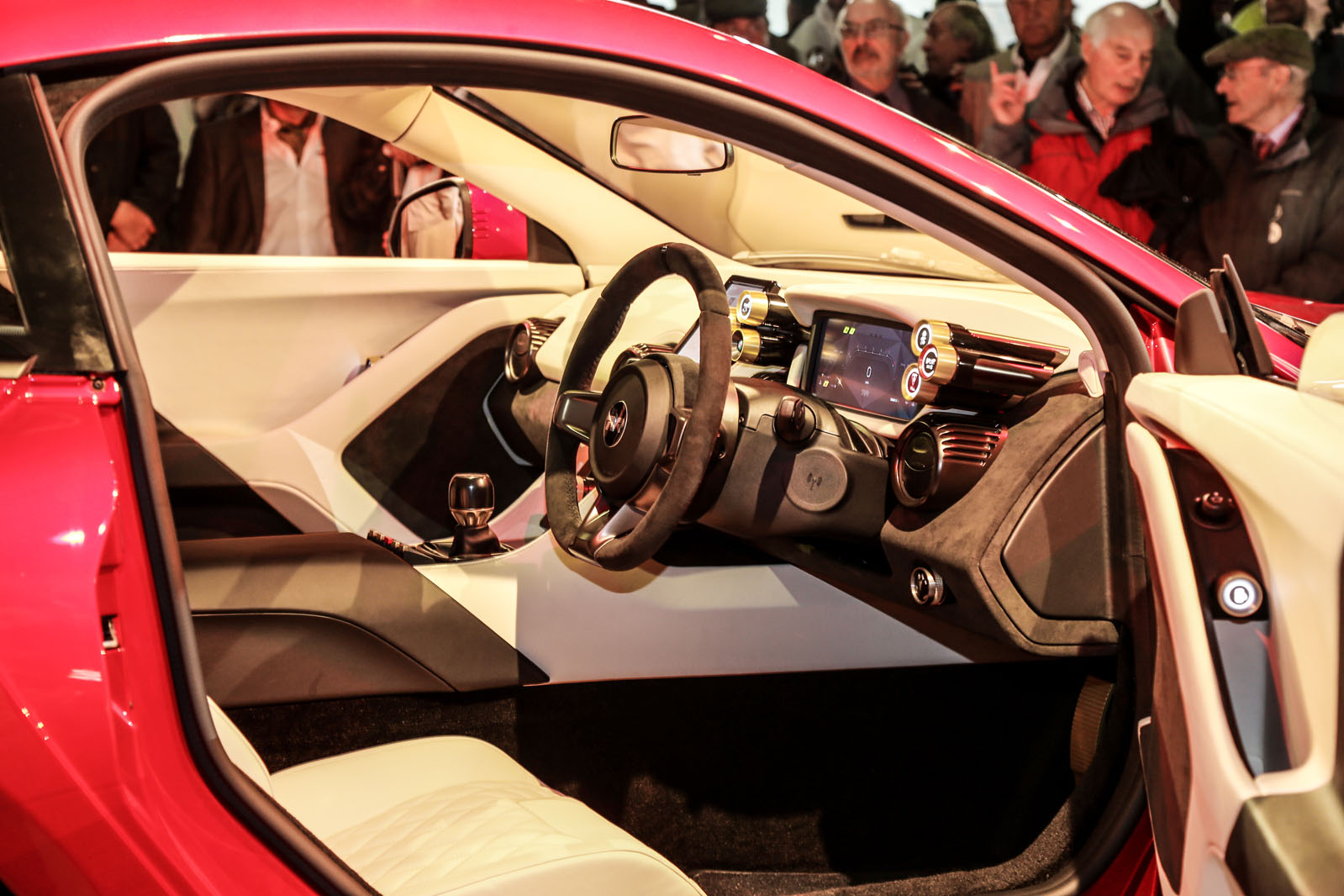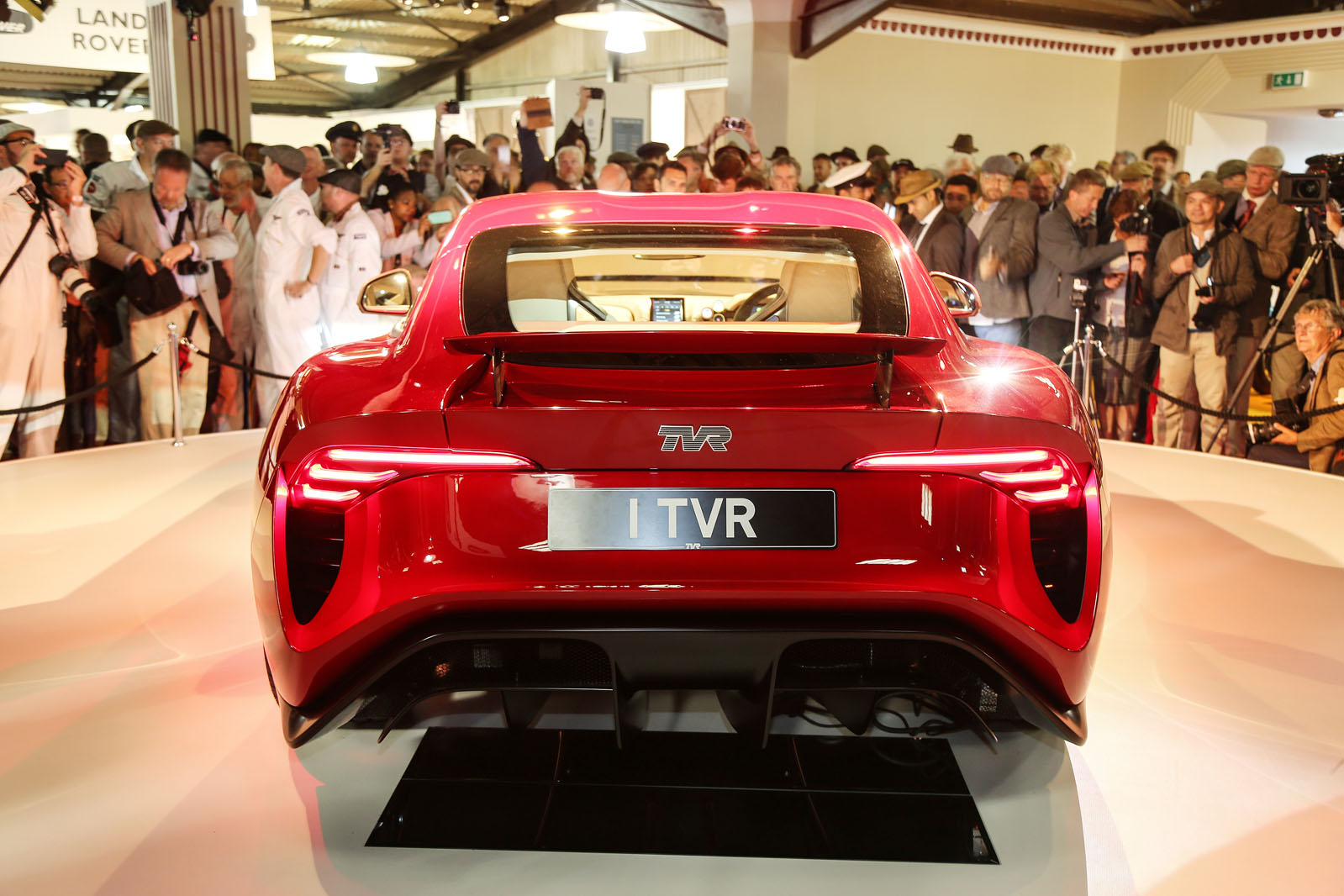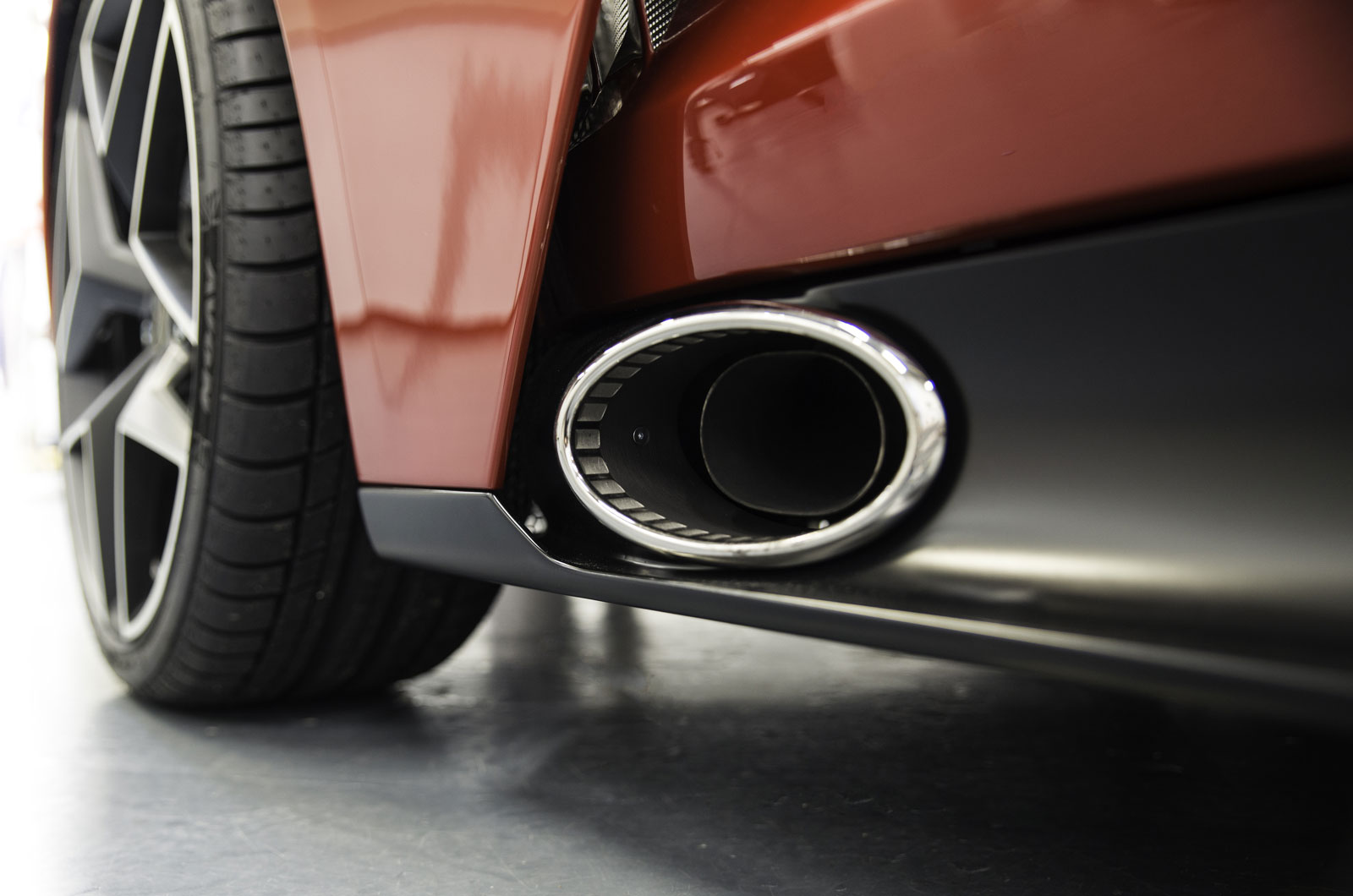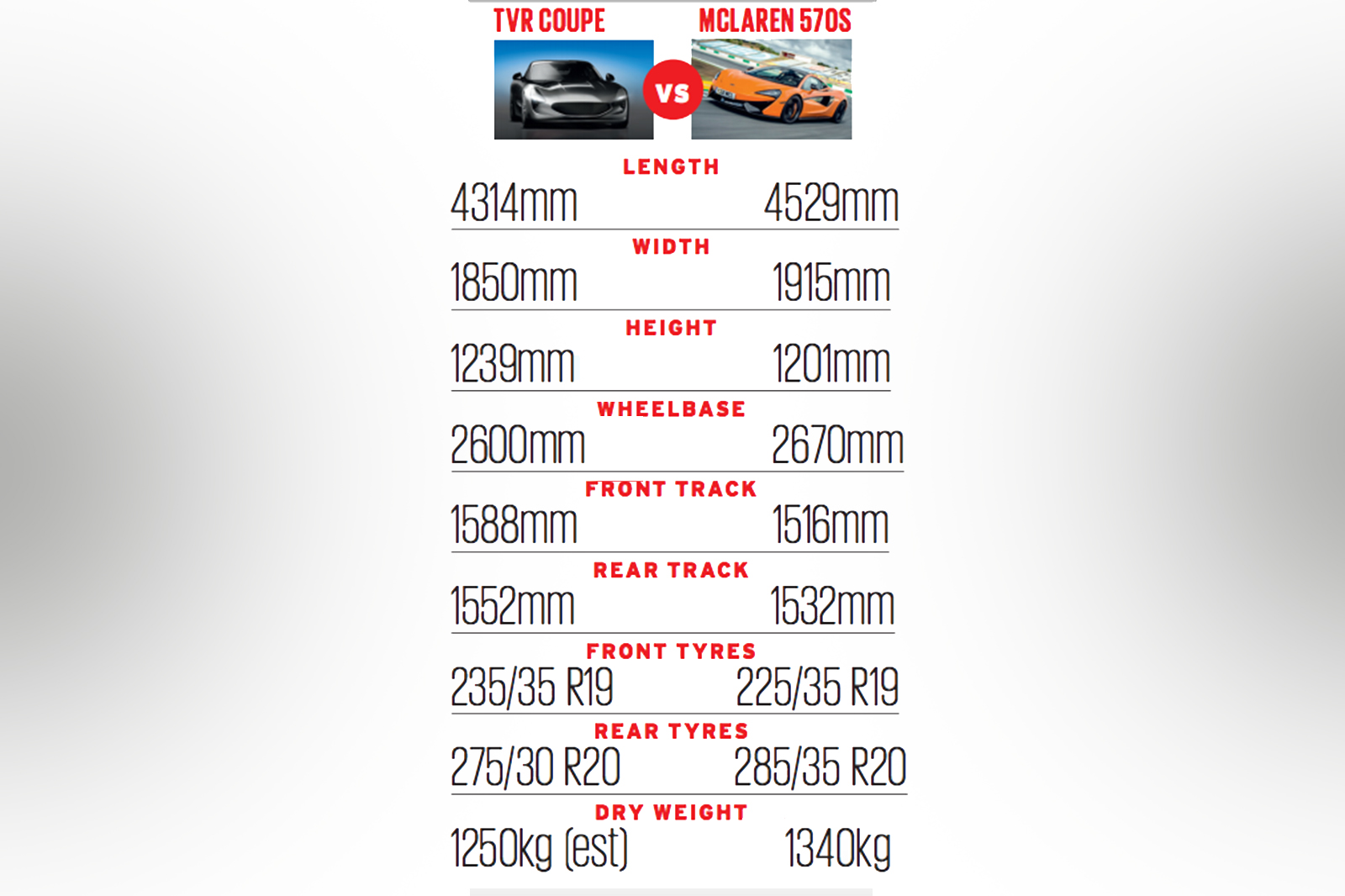All-new British V8 sports car uses Gordon Murray's iStream architecture and gets a flat floor for ground effect
TVR has shown its long-awaited sports car in motion, testing in a not-so-secret location - a dynamic debut for the Griffith.
The car was first revealed at the Goodwood Revival, where the reborn brand also confirmed the Griffith name for the upcoming Porsche 911 rival.
The new car is the first
to be built by TVR's current owners, a private millionaires' consortium fronted by computer-gaming magnate Les Edgar that four years ago mounted a successful
bid to buy the brand from Russian 'mini oligarch' Nikolai Smolenski. It was a day that diehard enthusiasts feared would never dawn: the big-hearted, big-performance sports car marque born in Blackpool 70 years ago ceased production in 2006 under Smolenski and resisted all attempts at revival until the current owners began a lengthy restoration process in 2013.
But now TVR is reborn and its first car is the two-seater Griffith, built on an all-new platform that uses Gordon Murray's innovative iStream architecture. Its striking design takes inspiration from the original TVR Griffith and Tuscan, but adopts more advanced aerodynamics to boost performance. David Seesing, a designer for TVR who "works between"
the company and Gordon Murray Design, sees maintaining the relationship with the marque's history-making older cars as one of his most important priorities.

The car's iStream structure features inner panels of carbonfibre bonded into a steel frame to provide immense rigidity and impressive crash integrity. The bodywork it comes wrapped in is also made from carbon – helping to keep the car's weight down to 1250kg. The car has a perfect 50:50 weight distribution.
Under the bonnet is a highly strung version of Ford's 5.0-litre quad-cam V8 Mustang engine, fettled by Cosworth to produce 500bhp. This has ensured that TVR's target for a 400bhp/tonne output has been met, and enables a sub-4sec 0-62mph time and top speed of over 200mph. Drive is sent to the rear wheels through a Tremec Magnum XL six-speed manual gearbox.
The Griffith is the second front-engined production car to use a flat floor, which TVR claims generates genuine ground-effect aerodynamics to improve high-speed stability. The car is 4314mm long, 1850mm wide and 1239mm tall, making it the most compact car in a class. The 911, for example, is 185mm longer, 42mm wider and 55mm taller, emphasising the smaller scale of the Griffith.

The Griffith has been set up with driving enjoyment as priority over ultimate lap time, with TVR stating that it uses "intelligent engineering over electronic aids". The car sits on double wishbone suspension with adjustable coilover dampers at both the front and rear. Power steering is electrically assisted and braking is handled by six-piston aluminium calipers and two-piece 370mm vented floating discs at the front, and four-piston calipers with 350mm vented discs at the rear. The wheels are of 19in diameter and 235mm width at the front, 20in diameter and 235mm width at the back.
Edgar said: "Today's unveiling is the culmination of nearly three years of tireless work by the team, and we're all proud to be able to show the new TVR Griffith to the world. This is unmistakably a TVR, a British muscle car that's as awesome and brutal as it is charismatic and refined. Importantly, the new TVR offers levels of technical sophistication, comfort, reliability and practicality never seen by the brand before.
"Although our show car can't be driven at the Revival, given the historic nature of the event, the show car is a fully drivable, fully finished car designed to be robustly test driven straight after the wraps come off."

The first 500 cars will be specially configured and badged Launch Editions. Most have already been reserved by a faithful customer group dubbed the TVR 500. Most members placed £5000 deposits around 18 months ago and are on course to receive their cars during 2019. Launch Editions will be painted in bespoke colours and get their own version of the car's infotainment system. Prices for the new model start at £90,000, after which they are expected to go both upwards and downwards depending on trim
and equipment. However,
at launch, TVR bosses want the first
car to embody their determination to offer "a lot of bang for your buck", as TVRs have always done.
Murray's iStream process is delivered via a new-design factory
that is claimed to provide
new levels of compactness and efficiency. With Welsh government financial help, TVR is understood to be putting around £30 million into re-equipping an existing 184,000sq ft factory in the Rassau Industrial Estate, Ebbw Vale, close to the site of the proposed Circuit of Wales. TVR insists its plans won't be affected by any circuit decision and it expects to generate up to 150 jobs when its production gets into full swing.

Edgar said TVR is on track to take possession of the factory in the second quarter next year. The company isn't offering a precise timetable beyond that, but one convincing scenario is that factory preparation will take three to six months, pilot production should start before the end of the year and the first production cars should be on their way to early customers in the first quarter of 2019.
The production aim is to make and sell "the vast majority" of the TVR 500 launch-edition cars in 2019, after which annual production will grow to around 1000 cars. The debut of a second model, probably a convertible, and subsequent higher-performance, lightweight models reveal a potential annual production of around 2000 to 2200 cars "by about year five". That number neatly matches current European Small Series type approval regulations for a two-car line-up.
TVR will concentrate at first on selling in the UK market, doing new-car business from its Ebbw Vale factory in the early years, although it aims also to involve "heritage service centres" (ie existing TVR specialists) in its new-car business. It is already signing up European distributors too, but US sales aren't in the frame for the foreseeable future.
At first, the priority will be
to keep faith with the original TVR 500, whose money
the company will have been holding for well over two
years by the time the first customers receive their cars. Several months ago, Edgar
and colleagues moved to keep the group involved by staging
a series of weekend "meet the team" meetings, during which a full-sized model was displayed and new detail was revealed.
"We lost about half a dozen people from those events," said Edgar, "but we gained 18 or 20. It was amazing to see at first hand how much they care."
Additional reporting by Sam Sheehan
How the best of British compare
The new TVR, with its front/mid-mounted, normally aspirated V8, could hardly be more different from another recently arrived British GT, the mid-engined turbocharged McLaren 570S,
yet the two promise very similar performance - a power-to-weight ratio of around 400bhp per tonne and a resulting, impressive 0-100mph time of about 6.4sec. The TVR is taller but narrower and impressively light, one of the virtues of its Gordon Murray-evolved iStream construction. Here's how the two cars compare.

How the new TVR broke cover
Autocar was first, on 12 June 2013, to break the story that TVR's old-established name and marque values had been rescued by a group of millionaire enthusiasts who had bought the company's name and remaining assets from its former owner, Smolenski.
First details of the car the partners would build emerged from a secret Autocar briefing a fortnight later and resulted in a 26 June cover story that also included the first interview with the new company's boss, Edgar.
By April 2014, we were talking about a new R&D centre in south England, but the real meat of the tale emerged on 3 June 2015, when we revealed the new TVR would be shaped and engineered at Gordon Murray Design (GMD) and powered by a Cosworth-modified Ford Mustang V8.
After that, details
came to light slowly. By July 2015, we knew the company had started taking deposits for its first 500 cars. By 7 October, we had visited Cosworth
in Northamptonshire to see TVR's bosses start the first Cosworth-modded Ford V8 on the dyno. By January 2016, we knew the chassis would be made using GMD's iStream Carbon process. By March 2016, we learned that TVR's new factory would be in Wales.
The most recent big story was TVR's series of weekend meetings for prospective buyers at GMD in March this year, where a clay model was shown for the first time. It justified another TVR cover story on 22 March and contained the first new TVR blueprint.
Related stories:
New TVR sports car to use Gordon Murray's iStream Carbon process
Insight: Why TVR is destined for success
Insight: Will 'back to basics' still work for TVR?